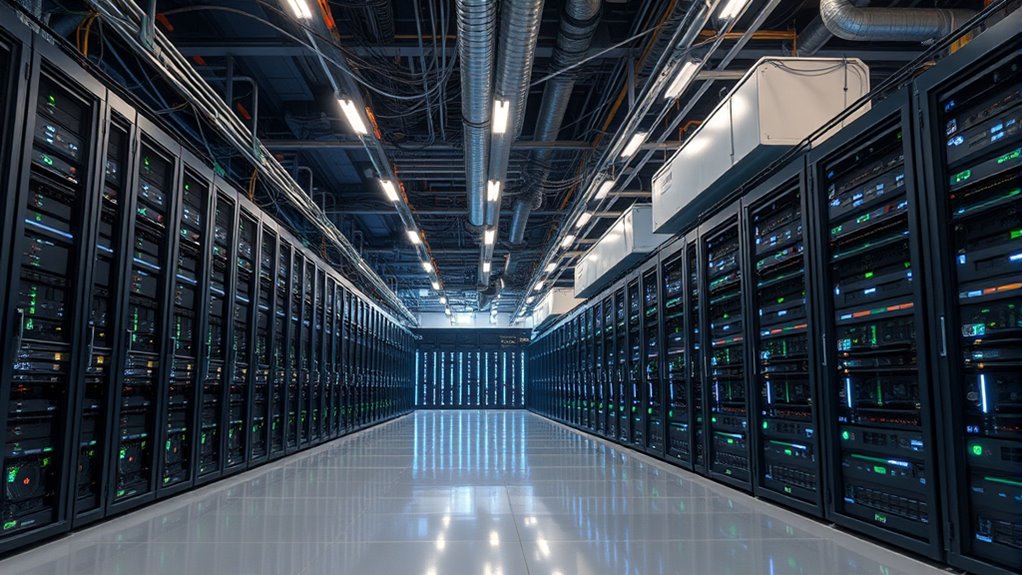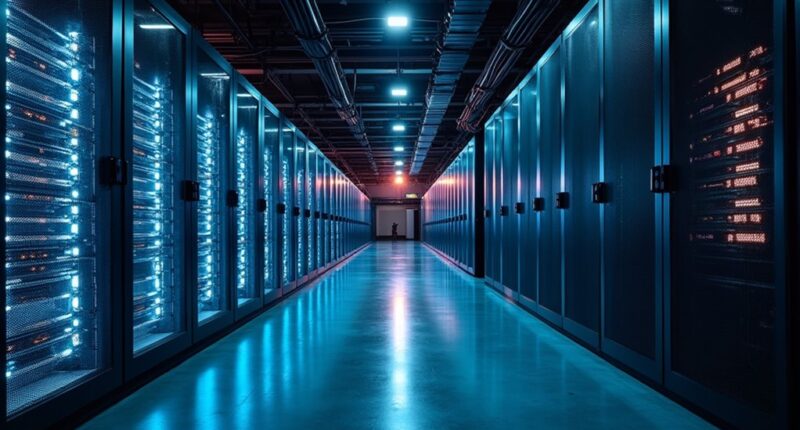OpenAI’s infrastructure race shows just how costly and complex AI development has become. With investments targeting hundreds of billions of dollars and thousands of new jobs, the scale is staggering. Building data centers, securing energy, and managing resources push costs higher, while risks of oversupply and environmental impacts loom. If you want to see how these huge efforts could shape AI’s future and the economy, there’s more to explore ahead.
Key Takeaways
- OpenAI’s Stargate project aims for a $500 billion investment and 10GW capacity by 2025, highlighting massive infrastructure costs.
- Total AI infrastructure spending is projected to reach $3-4 trillion by 2030, reflecting enormous financial commitments.
- Building AI data centers requires significant energy and water resources, adding environmental and sustainability costs.
- Industry investments involve billions from sovereign funds and major tech deals, emphasizing the staggering financial scale.
- Infrastructure expansion faces risks like overinvestment, delays, and resource constraints, potentially leading to stranded assets.

OpenAI is rapidly expanding its AI infrastructure in a race to dominate the future of artificial intelligence. This push involves Stargate, a major platform developed with Oracle and SoftBank, aiming for an astonishing $500 billion investment and a capacity of 10 gigawatts by 2025. Right now, nearly 7 gigawatts are already planned, with five new U.S. data center sites announced to bolster existing facilities like the flagship in Abilene, Texas. The July deal with Oracle alone targets an additional 4.5 gigawatts, valued at over $300 billion across five years. As a result, you’re witnessing a massive infrastructure buildout that promises to create more than 25,000 onsite jobs, plus tens of thousands more in supporting sectors all across the U.S. Incorporating natural materials is crucial for creating a sustainable and efficient infrastructure.
OpenAI’s Stargate project aims for $500 billion and 10GW capacity by 2025, transforming U.S. AI infrastructure and job markets.
This level of investment isn’t happening in isolation. The industry is experiencing a surge in venture funding for AI startups, surpassing previous cycles in crypto and mobility tech. Sovereign wealth funds are pouring billions into these efforts, betting on AI’s transformative potential. But the risk is clear: investments often precede widespread adoption, raising concerns about oversupply. If demand stalls, vast infrastructure assets risk becoming stranded, turning massive capital into dead weight. As a participant in this race, you must understand that building such infrastructure isn’t just about money—it’s about balancing these investments with tangible business outcomes. Without clear returns, the risk of a bust looms large.
Scaling AI infrastructure isn’t just about capital; it faces real physical and environmental challenges. Land availability, community resistance, and the enormous energy and water needs of data centers can bottleneck progress. Skilled labor shortages extend beyond engineers to include technicians, electricians, and construction workers—all crucial for rapid expansion. This creates a complex puzzle: how to sustain growth while managing resource constraints. Major players like Meta, Google, and Microsoft are investing heavily, with industry estimates suggesting that between $3 trillion and $4 trillion will be spent on AI infrastructure by 2030. Stargate, with its unprecedented pledge of $500 billion, is arguably the largest project in history, though delays and internal disagreements have slowed progress. Recent reports indicate that global investments in AI infrastructure are reaching unprecedented levels, reflecting the sector’s rapid growth.
Supporting all of this is a policy framework that emphasizes responsible growth. OpenAI’s Economic Blueprint urges proactive U.S. policies to maximize AI’s benefits—creating new jobs in data centers, chip manufacturing, and energy infrastructure—while advocating for equitable distribution of gains. The blueprint warns against global autocratic control of AI, emphasizing the importance of open innovation. For you, this means that the future of AI infrastructure hinges not only on financial might but also on thoughtful regulation, sustainable practices, and collaboration among developers, businesses, and policymakers. The costs are staggering, but the stakes for technological leadership and economic growth are even higher.
Frequently Asked Questions
How Does Openai Fund Its Infrastructure Investments?
You can see that OpenAI funds its infrastructure investments through a mix of massive funding rounds, strategic partnerships, and creative financing. They’ve raised billions from investors, including a $40 billion funding round at a $300 billion valuation. They also rely on partnerships with chipmakers like Nvidia, AMD, and Oracle, which often involve circular financing, equity stakes, and revenue sharing. This combination helps them scale quickly despite not yet being profitable.
What Are the Environmental Impacts of AI Infrastructure?
Think of AI infrastructure as a double-edged sword—you benefit from its power, but it cuts deep into our environment. You should know that AI’s energy use is skyrocketing, with inference now responsible for most consumption, and water demands strain local supplies. Hardware mining damages ecosystems, and data centers often rely on fossil fuels, increasing emissions. Your awareness can push for sustainable practices to balance innovation with environmental health.
How Does Infrastructure Scale With AI Model Size?
As AI model size grows, your infrastructure needs to scale up considerably. Larger models demand more compute power, which means expanding data center capacity and investing billions in hardware. You’ll need advanced processors and faster networking to handle increased data processing. This growth also accelerates obsolescence of hardware, requiring continuous upgrades. In short, bigger AI models push you to expand infrastructure rapidly, increasing costs and complexity to support their computational demands effectively.
What Are the Security Risks Associated With AI Infrastructure?
You face several security risks with AI infrastructure. Attackers might exploit APIs through weak authentication or input manipulation, risking data leaks or service disruptions. Hardware vulnerabilities, like side-channel attacks, can leak sensitive info. Supply chain attacks threaten hardware and software integrity. Additionally, model poisoning and data manipulation can embed backdoors or bias. AI-powered cyberattacks, such as deepfakes or phishing, further escalate risks, demanding robust security measures like strong authentication, continuous monitoring, and rigorous validation.
How Do Other Organizations Manage AI Infrastructure Costs?
You should know that 85% of companies miss AI infrastructure cost forecasts by over 10%, highlighting the challenge of managing expenses. To stay in control, organizations use cost tagging for precise tracking, set automated spending caps, and adopt hybrid cloud solutions to balance costs and scalability. They also leverage cloud management tools, virtualization, and energy-efficient hardware to optimize resource use and prevent budget overruns.
Conclusion
Just as Icarus soared toward the sun, you realize that chasing the pinnacle of AI innovation comes with soaring costs and risks. OpenAI’s relentless infrastructure race shows that pushing boundaries demands not only brilliant ideas but also vast resources. If you’re not careful, you might find yourself too close to the flames of extravagance. So, remember, even in the pursuit of greatness, wisdom must guide your flight—lest you fall back to Earth, humbled by the true cost of progress.









